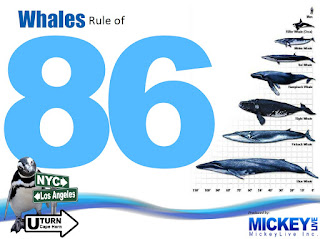If you are going to hang out with whales, there are many types to choose from. It seems like there are some automatic goals when you are heading toward the south pole.
Probably first of all, you hope to see penguins. You just don't ever get to do that up north where we live. If you want to hang with penguins you pretty much have to travel to Australia, New Zealand, South Africa, South America, or Antarctica.
The second thing you think of is probably mountains and ice. I should have said icebergs and although I did see literature about that when researching the trip, I didn't realize how important the icebergs were. I had seen icebergs in Alaska but they weren't the size of a 5 story tall super Walmart.
Then there are Whales. As we planned our trip I definitely hoped to see a whale or two. Apparently I wasn't the only one because Mickey Live did a lecture on whales. There are 86 different kinds of whales out there. If we were lucky, we had a chance to see one of three or more species of whale.
The three species of whales that we might get to see were the Orca (commonly called Killer Whales), the Minke, and Humpback. In the chronology of our trip this would be the 6th day. Tomorrow we would be entering the Beagle Channel and heading toward Ushuaia, Argentina, the city that calls itself "The end of the World".
Following this same chronology, this was the day I saw my first Orca.
We were heading south (duh!) along the coast of Argentina and Mandy and I were sitting by the window in a coffee shop on the 5th deck (we spent a lot of time in a coffee shop by the window on the 5th deck). Out of the corner of my eye I saw what I thought was a dolphin jumping. Upon closer examination I realized the dorsal fin was way too long and when the whale came out for air I could clearly see the white underbelly (don't get a lot of that on dolphins). I didn't try to take a picture because, well, taking pictures through the window isn't what the cool kids do.
Humpback: For me, the big goal of the trip was the Humpback whale. As whales go, the Humpback is the 4th largest species. They grow up to 52 feet long (the size of a school bus) and weigh in at over 60,000 pounds (some are as much as three tons over 60,000 pounds). These marine mammals can be found literally all over the planet. They don't get up to the Arctic, but I've seen them in Oregon, San Francisco and the inland Alaska passage near Juneau.
The Orca is pretty small as whales go. The females range between 3,000 and 6,000 pounds. The males run twice that size. A big male Orca can grow to 26 feet long (that would be about 8 feet longer than a Chevrolet crew cab pickup with a full size bed. The orca is the biggest member of the dolphin family and they like to hunt in packs (not unlike wolves). A hunting group (called a pod) can contain as many as 40 whales. The female orcas lead the pod (they are a matriarchal society) and these whales typically live 50 to 80 years.
Minke: There are two known species of minke whales; the north Atlantic minke and the Antarctic minke (guess which one we were most likely to see). Minke whales are in the same family as the blue whale and the humpback whale. They are the most plentiful in this family (called the Rorqual family of whales). Minke whales are a bit shorter (up to 24 feet long) and a bit heaver (up to 22,000 pounds) than Orcas. The females typically grow a little bigger than the males. These whales are filter feeders meaning they have Baleen bristles (think of the bristles on a comb) that allows them to pass water through the filters and trap the food. They filter out and eat small fish, krill, cod, herring, capelin and pollock. For the most part minke whales travel alone or in small pods of 2 to 3 whales. They can hold their breath for up to 25 minutes and have been know to swim at speeds of up to 24 miles per hour.






No comments:
Post a Comment